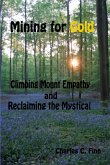Diane Lapp, Thomas Devere Wolsey, Karen Wood
Mining Complex Text, Grades 2-5
Using and Creating Graphic Organizers to Grasp Content and Share New Understandings
Diane Lapp, Thomas Devere Wolsey, Karen Wood
Mining Complex Text, Grades 2-5
Using and Creating Graphic Organizers to Grasp Content and Share New Understandings
- Broschiertes Buch
- Merkliste
- Auf die Merkliste
- Bewerten Bewerten
- Teilen
- Produkt teilen
- Produkterinnerung
- Produkterinnerung
Your power tools for making the complex comprehensible Now more than ever, our students are being asked to do highly advanced thinking, talking, and writing around their reading. If only there were ingenious new tools that could give our students the space to tease apart complex ideas in order to comprehend and weld their understandings into a new whole. Good news: these tools exist-Mining Complex Text. You'll learn how graphic organizers can: Help students read, reread, and take notes on a text Promote students' oral sharing of information and their ideas Elevate organized note-making from…mehr
Andere Kunden interessierten sich auch für
![Development Document for Proposed Effluent Limitations Guidelines, New Source Performance Standards, and Pretreatment Standards for the: Coal Mining P Development Document for Proposed Effluent Limitations Guidelines, New Source Performance Standards, and Pretreatment Standards for the: Coal Mining P]() Development Document for Proposed Effluent Limitations Guidelines, New Source Performance Standards, and Pretreatment Standards for the: Coal Mining P58,99 €
Development Document for Proposed Effluent Limitations Guidelines, New Source Performance Standards, and Pretreatment Standards for the: Coal Mining P58,99 €![Evaluating the U.S. Military's Development of Strategic and Operational Doctrine for Non-Lethal Weapons in a Complex Security Environment Evaluating the U.S. Military's Development of Strategic and Operational Doctrine for Non-Lethal Weapons in a Complex Security Environment]() James S. OgawaEvaluating the U.S. Military's Development of Strategic and Operational Doctrine for Non-Lethal Weapons in a Complex Security Environment54,99 €
James S. OgawaEvaluating the U.S. Military's Development of Strategic and Operational Doctrine for Non-Lethal Weapons in a Complex Security Environment54,99 €![Mining for Gold Mining for Gold]() Charles FinnMining for Gold11,99 €
Charles FinnMining for Gold11,99 €![AF Rescue 2030: A Multidimensional Force for a Complex World AF Rescue 2030: A Multidimensional Force for a Complex World]() Jason HanoverAF Rescue 2030: A Multidimensional Force for a Complex World54,99 €
Jason HanoverAF Rescue 2030: A Multidimensional Force for a Complex World54,99 €![Development Document for Proposed Effluent Limitations Guidelines and New Source Performance Standards for the: Offshore Subcategory of the Ore Mining Development Document for Proposed Effluent Limitations Guidelines and New Source Performance Standards for the: Offshore Subcategory of the Ore Mining]() Development Document for Proposed Effluent Limitations Guidelines and New Source Performance Standards for the: Offshore Subcategory of the Ore Mining54,99 €
Development Document for Proposed Effluent Limitations Guidelines and New Source Performance Standards for the: Offshore Subcategory of the Ore Mining54,99 €![Modeling and Simulation Architecture for Studying Doppler-Based Radar with Complex Environments Modeling and Simulation Architecture for Studying Doppler-Based Radar with Complex Environments]() Nicholas J. AmatoModeling and Simulation Architecture for Studying Doppler-Based Radar with Complex Environments58,99 €
Nicholas J. AmatoModeling and Simulation Architecture for Studying Doppler-Based Radar with Complex Environments58,99 €![Navigating Between Scylla and Charybdis: The Odyssean Leader in a Complex Environment Navigating Between Scylla and Charybdis: The Odyssean Leader in a Complex Environment]() Russell D. DriggersNavigating Between Scylla and Charybdis: The Odyssean Leader in a Complex Environment54,99 €
Russell D. DriggersNavigating Between Scylla and Charybdis: The Odyssean Leader in a Complex Environment54,99 €-
-
-
Your power tools for making the complex comprehensible Now more than ever, our students are being asked to do highly advanced thinking, talking, and writing around their reading. If only there were ingenious new tools that could give our students the space to tease apart complex ideas in order to comprehend and weld their understandings into a new whole. Good news: these tools exist-Mining Complex Text. You'll learn how graphic organizers can: Help students read, reread, and take notes on a text Promote students' oral sharing of information and their ideas Elevate organized note-making from complex text(s) Scaffold students' narrative and informational writing
Produktdetails
- Produktdetails
- Verlag: Corwin
- Seitenzahl: 184
- Erscheinungstermin: 16. Oktober 2014
- Englisch
- Abmessung: 280mm x 216mm x 10mm
- Gewicht: 479g
- ISBN-13: 9781483316291
- ISBN-10: 1483316297
- Artikelnr.: 41455818
- Herstellerkennzeichnung
- Libri GmbH
- Europaallee 1
- 36244 Bad Hersfeld
- gpsr@libri.de
- Verlag: Corwin
- Seitenzahl: 184
- Erscheinungstermin: 16. Oktober 2014
- Englisch
- Abmessung: 280mm x 216mm x 10mm
- Gewicht: 479g
- ISBN-13: 9781483316291
- ISBN-10: 1483316297
- Artikelnr.: 41455818
- Herstellerkennzeichnung
- Libri GmbH
- Europaallee 1
- 36244 Bad Hersfeld
- gpsr@libri.de
Diane Lapp, EdD, is a distinguished professor of education at San Diego State University where her work continues to be applied to schools. She is also an instructional coach and teacher at Health Sciences High & Middle College. Throughout her career, Diane has taught in elementary, middle, and high schools. Her major areas of research and instruction regard issues related to the planning and assessment of very intentional literacy instruction and learning. A member of both the California and the International Reading Halls of Fame, Diane has authored, coauthored, and edited numerous articles, columns, texts, handbooks and children's materials on instruction, assessment, and literacy related issues. Diane is the recipient of the ILA 2023 William S. Gray Citation of Merit, a prestigious award reserved for those who have made outstanding contributions to multiple facets of literacy development. Diane can be reached at lapp@sdsu.edu. Follow her on twitter @lappsdsu
Acknowledgments
Chapter 1. Graphic Organizers: Making the Complex Comprehensible
How to Think About Standards Alignment
How to Help Students Meet the Standards
Tips for Using Graphic Organizers Dynamically
How to Meet Eight Intertwined Academic Goals
What Lies Ahead in This Book
Chapter 2. Thinking on the Page: The Research Behind Why Graphic Organizers
Work
Picture This: Visuals Quicken and Deepen Text Learning
General Tips: How to Use Graphic Organizers Well
Tiered Organizers: Scaffold Student Progress
Examples of Tiered Graphic Organizers
Adapting Graphic Organizers for Tiered Learning
A Sample Tiered Lesson
At-a-Glance Chart of Graphic Organizers Matched to Academic Goals
Chapter 3. Using Graphic Organizers to Acquire Academic Vocabulary
Frayer Organizer
Concept/Definition Map
Word Map
Chapter 4. Graphic Organizers Support Literary Text Reading and Writing
Tasks
Character Graphic
Freytag's Pyramid
Chapter 5. Graphic Organizers Support Informational Text Reading and
Writing Tasks
Text Search and Find Board
4-Square With a Diamond
Modified KWL
Tabbed Book Manipulative
Chapter 6. Graphic Organizers Support Students' Reading Proficiencies
Somebody-Wanted-But-So
Understanding Text Structures: Five Text Types
Chapter 7. Graphic Organizers Boost Questioning and Responding
I-Chart and I-Guide
Flip Chart Manipulative
Text-Dependent Question/Response Organizer
Chapter 8. Graphic Organizers Foster Reading, Forming, and Writing Opinions
Six-Part Opinion Organizer
Thinking Map
Chapter 9. Graphic Organizers Support Collaboration
Project Management Organizer
Conclusion
Appendix
Glossary
References
Index
Chapter 1. Graphic Organizers: Making the Complex Comprehensible
How to Think About Standards Alignment
How to Help Students Meet the Standards
Tips for Using Graphic Organizers Dynamically
How to Meet Eight Intertwined Academic Goals
What Lies Ahead in This Book
Chapter 2. Thinking on the Page: The Research Behind Why Graphic Organizers
Work
Picture This: Visuals Quicken and Deepen Text Learning
General Tips: How to Use Graphic Organizers Well
Tiered Organizers: Scaffold Student Progress
Examples of Tiered Graphic Organizers
Adapting Graphic Organizers for Tiered Learning
A Sample Tiered Lesson
At-a-Glance Chart of Graphic Organizers Matched to Academic Goals
Chapter 3. Using Graphic Organizers to Acquire Academic Vocabulary
Frayer Organizer
Concept/Definition Map
Word Map
Chapter 4. Graphic Organizers Support Literary Text Reading and Writing
Tasks
Character Graphic
Freytag's Pyramid
Chapter 5. Graphic Organizers Support Informational Text Reading and
Writing Tasks
Text Search and Find Board
4-Square With a Diamond
Modified KWL
Tabbed Book Manipulative
Chapter 6. Graphic Organizers Support Students' Reading Proficiencies
Somebody-Wanted-But-So
Understanding Text Structures: Five Text Types
Chapter 7. Graphic Organizers Boost Questioning and Responding
I-Chart and I-Guide
Flip Chart Manipulative
Text-Dependent Question/Response Organizer
Chapter 8. Graphic Organizers Foster Reading, Forming, and Writing Opinions
Six-Part Opinion Organizer
Thinking Map
Chapter 9. Graphic Organizers Support Collaboration
Project Management Organizer
Conclusion
Appendix
Glossary
References
Index
Acknowledgments
Chapter 1. Graphic Organizers: Making the Complex Comprehensible
How to Think About Standards Alignment
How to Help Students Meet the Standards
Tips for Using Graphic Organizers Dynamically
How to Meet Eight Intertwined Academic Goals
What Lies Ahead in This Book
Chapter 2. Thinking on the Page: The Research Behind Why Graphic Organizers
Work
Picture This: Visuals Quicken and Deepen Text Learning
General Tips: How to Use Graphic Organizers Well
Tiered Organizers: Scaffold Student Progress
Examples of Tiered Graphic Organizers
Adapting Graphic Organizers for Tiered Learning
A Sample Tiered Lesson
At-a-Glance Chart of Graphic Organizers Matched to Academic Goals
Chapter 3. Using Graphic Organizers to Acquire Academic Vocabulary
Frayer Organizer
Concept/Definition Map
Word Map
Chapter 4. Graphic Organizers Support Literary Text Reading and Writing
Tasks
Character Graphic
Freytag's Pyramid
Chapter 5. Graphic Organizers Support Informational Text Reading and
Writing Tasks
Text Search and Find Board
4-Square With a Diamond
Modified KWL
Tabbed Book Manipulative
Chapter 6. Graphic Organizers Support Students' Reading Proficiencies
Somebody-Wanted-But-So
Understanding Text Structures: Five Text Types
Chapter 7. Graphic Organizers Boost Questioning and Responding
I-Chart and I-Guide
Flip Chart Manipulative
Text-Dependent Question/Response Organizer
Chapter 8. Graphic Organizers Foster Reading, Forming, and Writing Opinions
Six-Part Opinion Organizer
Thinking Map
Chapter 9. Graphic Organizers Support Collaboration
Project Management Organizer
Conclusion
Appendix
Glossary
References
Index
Chapter 1. Graphic Organizers: Making the Complex Comprehensible
How to Think About Standards Alignment
How to Help Students Meet the Standards
Tips for Using Graphic Organizers Dynamically
How to Meet Eight Intertwined Academic Goals
What Lies Ahead in This Book
Chapter 2. Thinking on the Page: The Research Behind Why Graphic Organizers
Work
Picture This: Visuals Quicken and Deepen Text Learning
General Tips: How to Use Graphic Organizers Well
Tiered Organizers: Scaffold Student Progress
Examples of Tiered Graphic Organizers
Adapting Graphic Organizers for Tiered Learning
A Sample Tiered Lesson
At-a-Glance Chart of Graphic Organizers Matched to Academic Goals
Chapter 3. Using Graphic Organizers to Acquire Academic Vocabulary
Frayer Organizer
Concept/Definition Map
Word Map
Chapter 4. Graphic Organizers Support Literary Text Reading and Writing
Tasks
Character Graphic
Freytag's Pyramid
Chapter 5. Graphic Organizers Support Informational Text Reading and
Writing Tasks
Text Search and Find Board
4-Square With a Diamond
Modified KWL
Tabbed Book Manipulative
Chapter 6. Graphic Organizers Support Students' Reading Proficiencies
Somebody-Wanted-But-So
Understanding Text Structures: Five Text Types
Chapter 7. Graphic Organizers Boost Questioning and Responding
I-Chart and I-Guide
Flip Chart Manipulative
Text-Dependent Question/Response Organizer
Chapter 8. Graphic Organizers Foster Reading, Forming, and Writing Opinions
Six-Part Opinion Organizer
Thinking Map
Chapter 9. Graphic Organizers Support Collaboration
Project Management Organizer
Conclusion
Appendix
Glossary
References
Index









